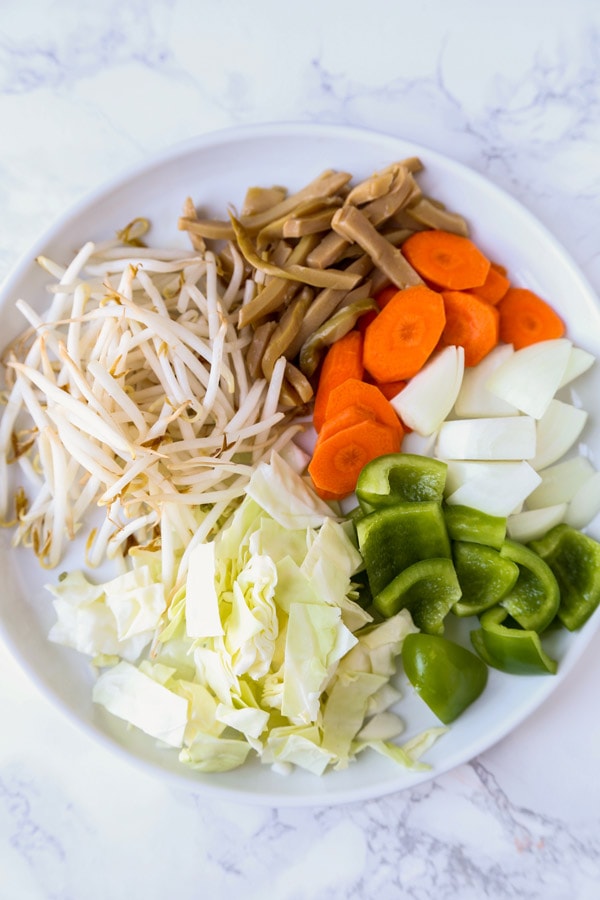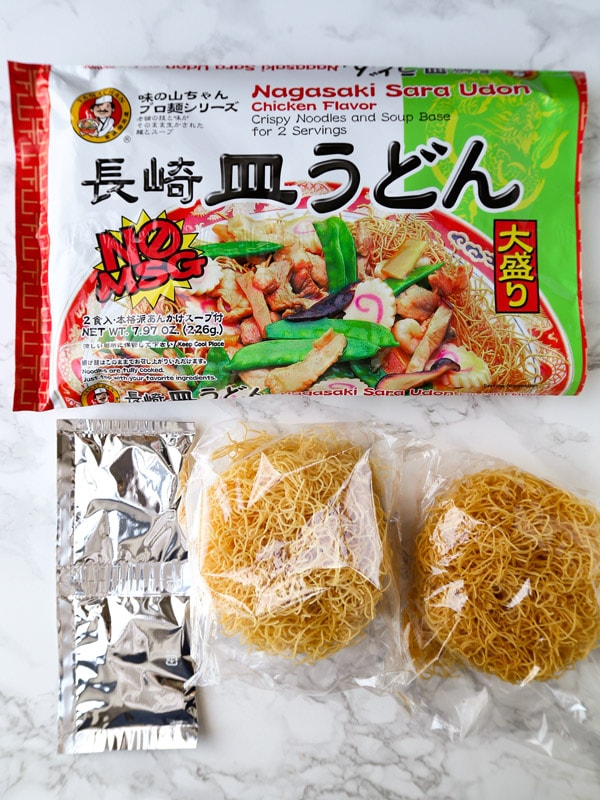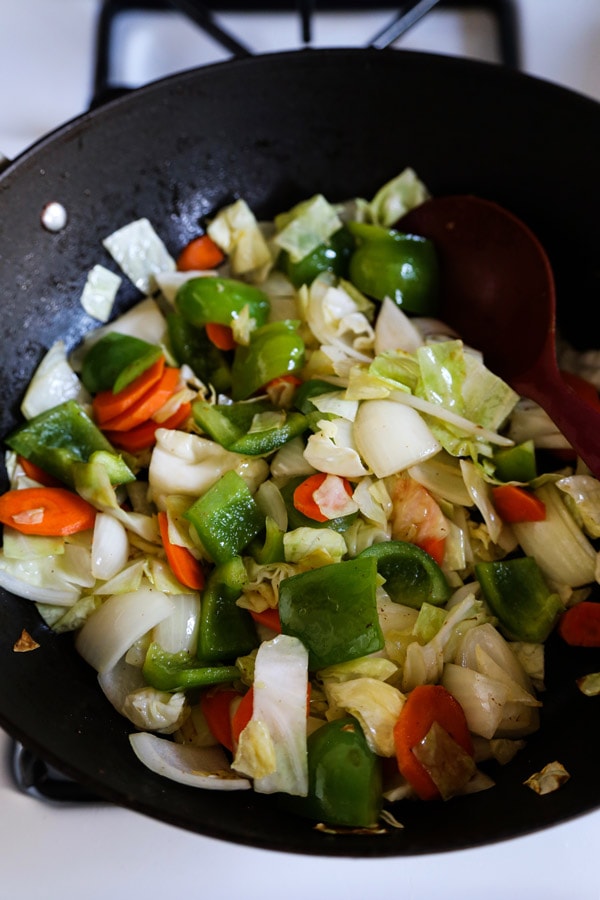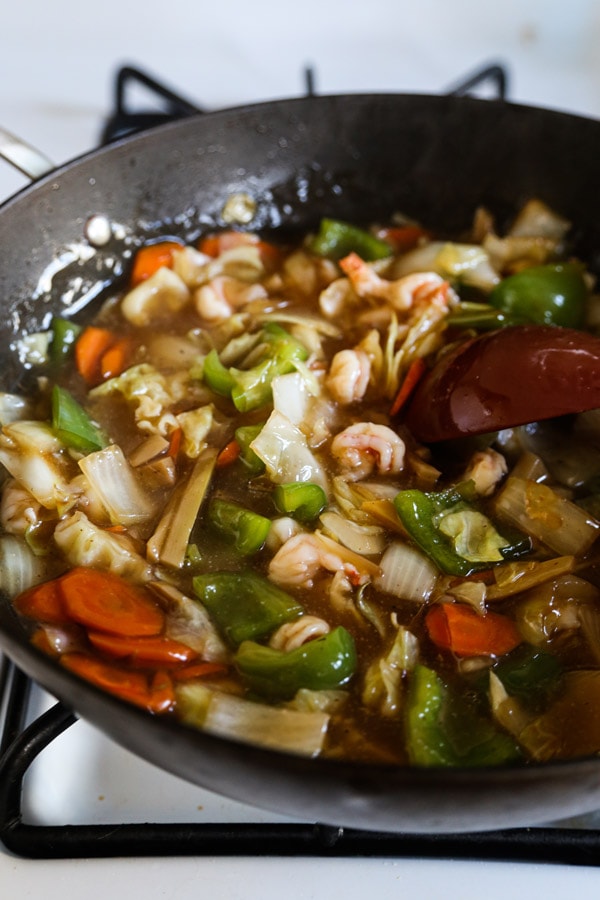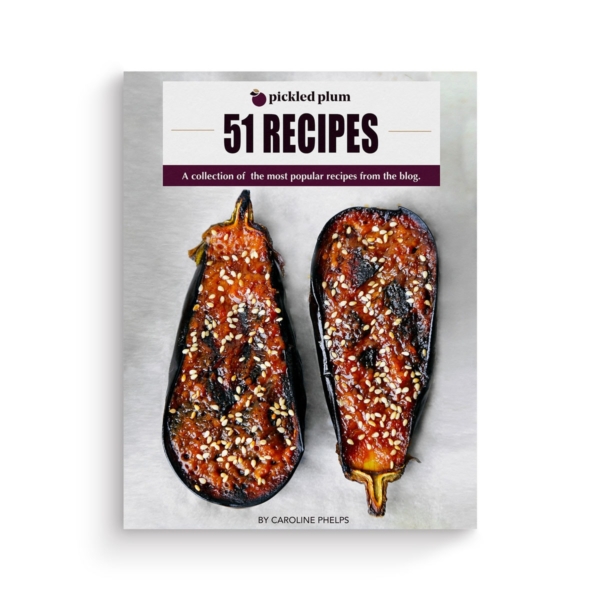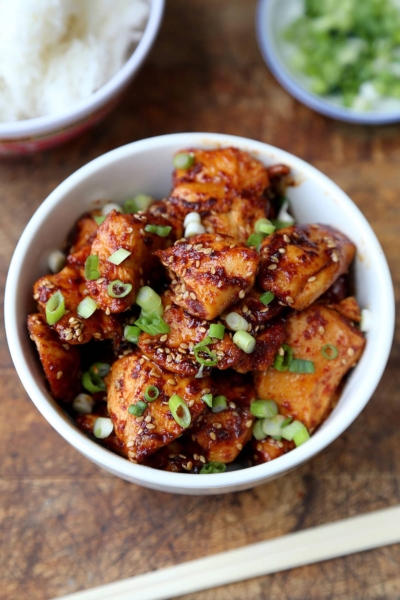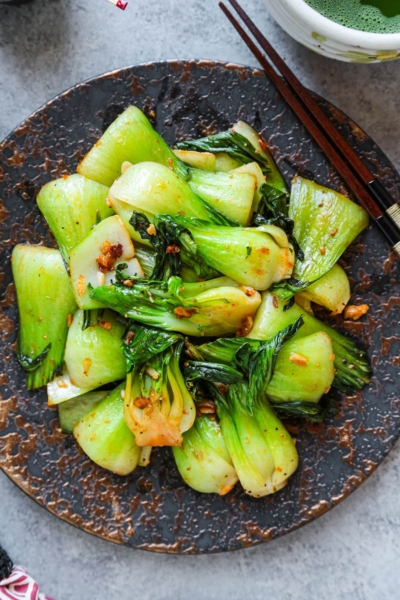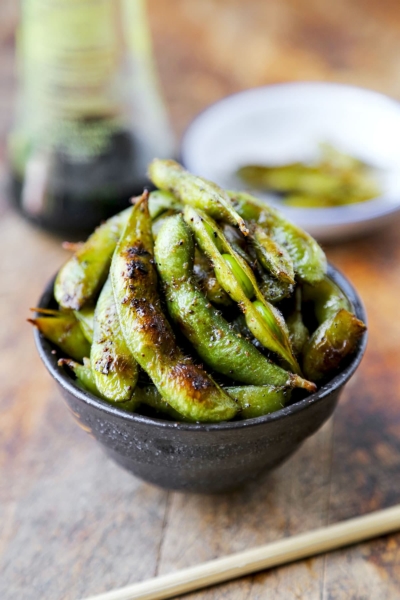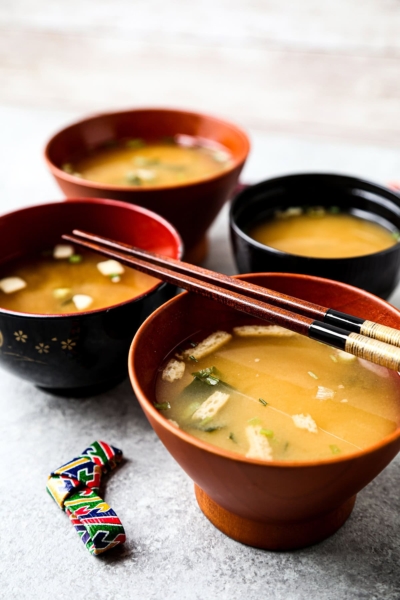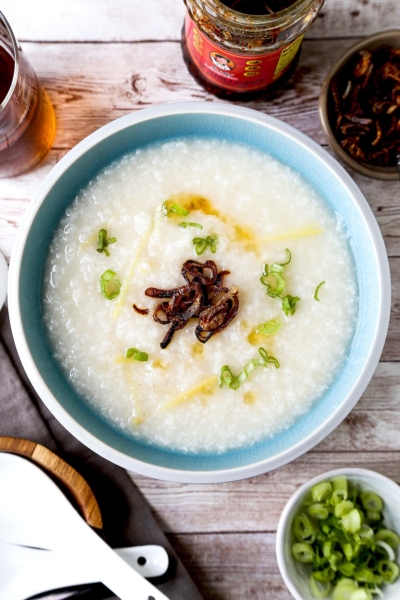It’s crispy noodle time! This chow mein / sara udon recipe has all the flavors – and textures! Make this Easy Cantonese Chow Mein in 20 minutes from start to finish.
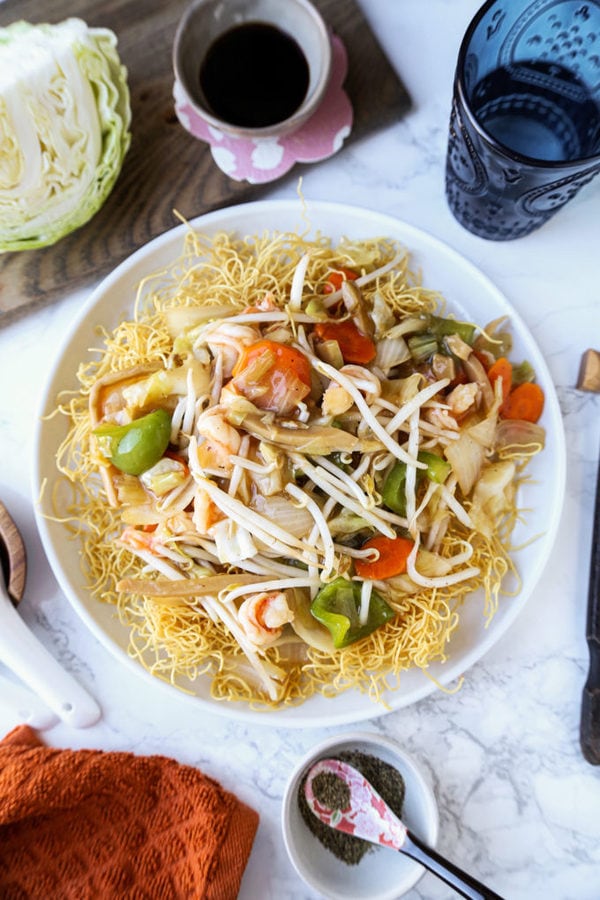
I’ve always had a soft spot in my heart for the crispy noodles used in Cantonese style chow mein. In fact, crispy chow mein is my go-to order when we hit our favorite restaurants in New York’s Chinatown.
And literally every single time we visit my mother in Japan, we’ll make at least one trip to Ringer Hut (a Japanese chain that specializes in champon and sara udon) for a bed of crispy noodles smothered in veggies, seafood and thick sauce. It’s a must!
So what does me eating crispy noodles in a restaurant in Japan have to do with Cantonese chow mein? Read on and I’ll tell you!
What is chow mein
Chow mein (炒面) is a Chinese noodle dish that features vegetables and protein cooked in a savory sauce. Translating literally to stir-fried noodles, chow mein recipes typically fall into two categories based primarily on the texture of the noodles.
- Steamed Chow Mein: This features soft noodles that have the sauce, vegetables and meat fully integrated during the cooking process. Check out my vegetable chow mein recipe here.
- Cantonese Chow Mein: Also known as Hong Kong style chow mein and crispy chow mein. This preparation calls for a bottom layer of crispy pan-fried noodles, topped with veggies and meat (or seafood, tofu, etc.) cooked in a thick sauce. This sauce is added to the bed of crispy noodles immediately prior to serving.
What I love most about Cantonese chow mein (aside from the flavor) is the texture. The crispy noodles begin to slightly soften when integrated with the sauce – however retain most of their crunch.
What’s the difference between cantonese chow mein and japanese sara udon
Cantonese chow mein runs some pretty significant parallels to a Japanese dish called sara udon. Now, sara udon (皿うどん) hails from the Nagasaki prefecture in Japan – and literally translates into plate noodles. And much like chow mein, it also features a bed of pan-fried crispy noodles smothered in a thick, savory sauce with veggies like cabbage and bean sprouts; seafood like shrimp, squid and fish cakes; as well as slivers of pork.
What I find interesting about the similarities between sara udon and Cantonese chow mein is that so many iconic Japanese recipes (especially noodle recipes) are adaptations of Chinese dishes.
So to oversimplify a nuanced issue, from a historical standpoint Nagasaki sara udon is an adapted version of Cantonese chow mein. Therefore from the perspective of pure flavor, they’re not that different at all 🙂
Ingredients for Cantonese Chow mein
- Vegetable Oil: Any neutral cooking oil will do the trick.
- Shrimp: Thaw and shell about a half-pound of medium-large shrimp.
- Onion, Carrot, Green Bell Pepper and Cabbage: This is your vegetable mixture. Great for flavor and added crunch. If you use napa cabbage, the leaves will really soak up the savory sauce. Yummy!
- Bamboo Shoots: Bamboo is one of those veggies that straddles the line perfectly between soft and crunchy texture. A must.
- Bean Sprouts: You’ll add fresh bean sprouts to the mix just before the final toss in the pan. This ensures that they will retain their perfect crispness. They’ll continue to soften in the sauce once served.
- Soy Sauce: For a little added umami 🙂
- Crispy Chow Mein Noodles: These pre-cooked Chinese noodles are easy to track down at most Asian grocery stores – and make the delicious nest for this chow mein / sara udon recipe.
- White or Black Pepper: Add this at the end to accommodate your taste. I love white ground pepper for its floral heat.
- Chicken Broth or Vegetable Broth: This is the savory base to our sauce.
- Oyster Sauce: This thick, brown wonder-condiment is earthy and savory, with the slightest sweetness around the edges.
- Sake: Cooking sake has a sweet, dry and salty flavor profile. Grab it at an Asian grocery store, or pick it up on Amazon.
- Sesame Oil: The toasted nuttiness of sesame oil ads a great depth of flavor to this chow mein sauce.
- Granulated Sugar: While this is an optional ingredient, I find that about a teaspoon of sugar is the perfect addition to make the otherwise savory sauce really pop!
- Cornstarch and Cold Water: Mix 2 tablespoons cornstarch with 5 tablespoons cold water to create a slurry. This will buttress the sauce and give it it’s trademark thickness.
Can I use a mix?
Now, if you have a Japanese grocery store in your neighborhood, you may be able to pick up a package of Yamachan sara udon mix. Inside you’ll find two servings of crispy noodles and sauce mixture that you can combine with your veggies and shrimp.
If you go with this method, you’ll still need to prep your vegetables and shrimp. But the noodles and sauce are covered!
To make it easy, I’ve got instructions in the recipe card below for making chow mein from scratch – and instructions for making a very similar sara udon with a little help from a package.
How to make chow mein / sara udon
- Place the crispy noodles on two separate plates and set aside.
- If you are making the sauce from scratch (without the Yamachan Sara Udon Mix), whisk all the ingredients for the sauce in a bowl and set aside. (If using the sara udon mix, follow instructions for sauce prep on the package).
- Heat a large wok or pan over medium high heat until it’s hot. This usually takes about 1 minute. Add 1 tablespoon of oil and swirl it around the pan. Then add shrimp and cook on each side for 2 minutes. Transfer the shrimp to a plate and set aside. This will keep it from overcooking.
- Using the same pan, add the remaining 1 tablespoon of oil. Add your onions, carrots, bell peppers and cabbage. Stir fry for 3-4 minutes, until vegetables are tender but still yield a little crunch. Then add soy sauce and toss to coat the vegetables evenly.
- Next, add bamboo shoots and cook for 1 minute. Return the shrimp to the pan and stir everything together.
- Add the sauce and bring to a boil. When the sauce thickens, add your beans sprouts, toss and turn the heat off. Pour the vegetables over the crispy noodles. Serve with white or black ground pepper.
Easy, right!? And you’ll love the mixture of soft and crunchy textures almost as much as you’ll love the flavor. Promise!
What to serve with Cantonese chow mein
Aside from the wonderful flavor and texture of these Chinese noodles, the best thing is that they go hand and hand with almost any Asian recipe you’d like to serve them with.
Having a light lunch? You could serve this Japanese miso soup recipe, these Korean scallion pancakes – or even these Chinese tea eggs for a balanced taste of Asia.
Or, if you feel like having a full-on Chinese meal, try these other delectable and easy Chinese recipes:
- Moo Goo Gai Pan 蘑菇雞片
- Szechuan Chicken 辣子鸡
- Chinese Eggplant With Garlic Sauce
- Easy Hunan Chicken
- Empress Chicken
Plus:
Did you like this Cantonese Chow Mein Recipe? Are there changes you made that you would like to share? Share your tips and recommendations in the comments section below!
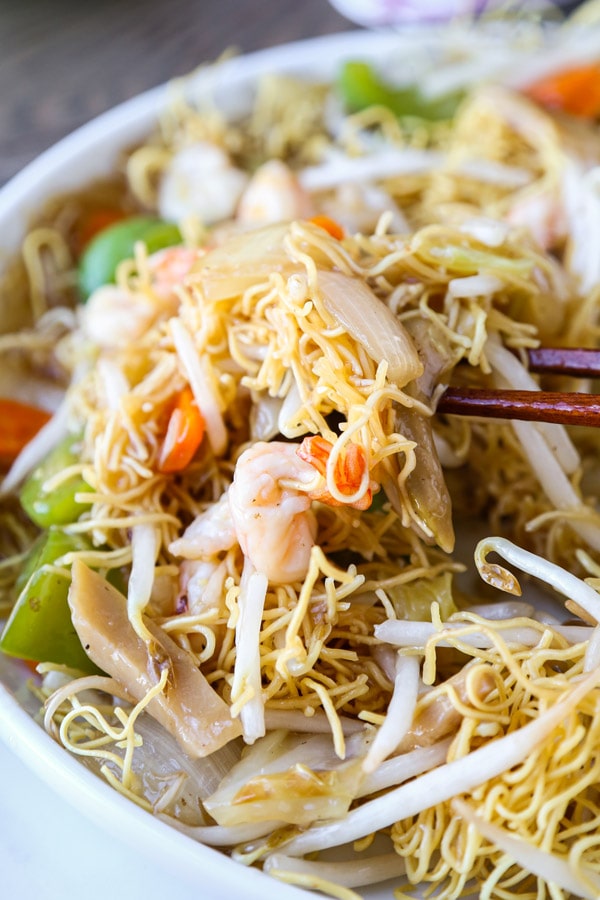
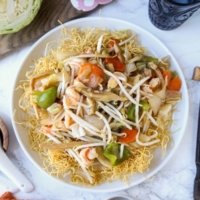
Easy Cantonese-Style Chow Mein (Sara Udon)
- Prep Time: 10 minutes
- Cook Time: 10 minutes
- Total Time: 20 minutes
- Yield: 2
- Category: Stir Fry
- Method: Pan frying
- Cuisine: Chinese
Description
A Cantonese chow mein / sara udon recipe you won’t be able to stop eating!
Ingredients
Using Yamachan Sara Udon Mix
- 2 tablespoons vegetable oil
- 1/2 pound (8 ounces) large shrimp, thawed, peeled
- 1 small onion, chopped
- 1 small carrot, chopped
- 1/2 green bell pepper, chopped
- 1 cup cabbage or napa cabbage, chopped
- 1 tablespoon soy sauce
- 1/4 cup bamboo shoots
- 1 cup beans sprouts
- 1 package Yamachan Sara Udon Mix
- 2 1/2 cup water
- White or black ground pepper to taste
Chow Mein Recipe From Scratch
- 2 tablespoons vegetable oil
- 1/2 pound (8 ounces) large shrimp, thawed, peeled
- 1 small onion, chopped
- 1 small carrot, chopped
- 1/2 green bell pepper, chopped
- 1 cup cabbage or napa cabbage, chopped
- 1 tablespoon soy sauce
- 1/4 cup bamboo shoots
- 1 cup beans sprouts
- 6 ounces crispy chow mein noodles
- White or black ground pepper to taste
Sauce:
- 1 1/2 cup chicken or vegetable broth
- 1 tablespoon sake
- 1 1/2 tablespoon oyster sauce
- 1 teaspoon sesame oil
- 1 teaspoon granulated sugar, optional
- 2 tablespoon cornstarch mixed with 5 tablespoons cold water
Instructions
- Place the crispy noodles on two separate plates and set aside.
- If you are making this recipe from scratch (without the Yamachan Sara Udon Mix), whisk all the ingredients for the sauce in a bowl and set aside.
- Heat a large wok or a pan on medium high until it’s hot – about 1 minute. Next add 1 tablespoon of oil and swirl it around. Add shrimp and cook on each side for 2 minutes. Transfer the shrimp to a plate and set aside.
- Using the same pan, add the remaining 1 tablespoon of oil. Add onions, carrot, bell pepper and cabbage, and stir fry for 3-4 minutes, until vegetables are tender but still yielding a little crunch. Then add soy sauce and toss to coat the vegetables evenly.
- Add bamboo shoots and cook for 1 minute. Return the shrimp to the pan and stir.
- Add the sauce mix and bring to a boil. When the sauce thickens, add beans sprouts, toss and turn the heat off. Pour the vegetables over the crispy noodles. Serve with white or black ground pepper.
Notes
Since the crispy noodles will begin to soften once the sauce is applied, this chow mein recipe is best fresh. If you’re planning on leftovers, be sure to store the sauce separately from the crispy noodles.
Nutrition
- Serving Size:
- Calories: 685
- Sugar: 12.4 g
- Sodium: 2123.4 mg
- Fat: 18.5 g
- Saturated Fat: 11.9 g
- Carbohydrates: 91.6 g
- Fiber: 7.8 g
- Protein: 40.9 g
- Cholesterol: 182.5 mg
